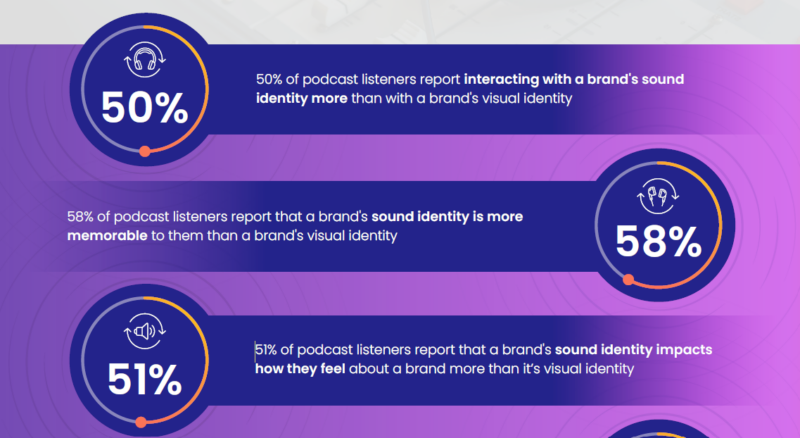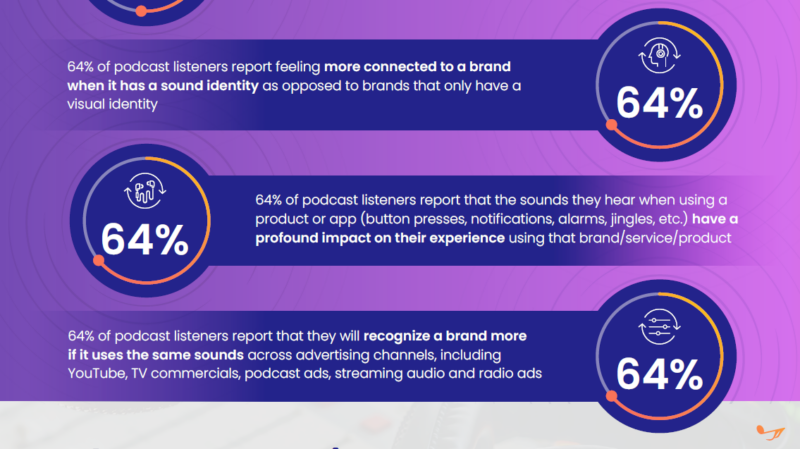In today’s fast-paced marketing landscape, the importance of a brand’s sonic identity has reached new heights. As consumers are bombarded with constant content across numerous platforms, brands seek innovative ways to stand out and create lasting connections. One of the most powerful tools they have? Sound.
Veritonic unveiled its latest study, “The Audio Advantage: Elevating Brand Experience Through Sound,” which uncovers the profound impact that sound has on brand recognition, memorability, and consumer connection—often surpassing the influence of visual identities. With audio continuing to play an ever-growing role in the digital marketing ecosystem, understanding how to leverage sound effectively is more critical than ever.


Key Findings
Here are some of the most compelling insights from the research:
- 50% of podcast listeners engage more with a brand’s sound identity than its visual identity. In the audio-first world of podcasting, brands that have a recognizable sonic presence are seeing a deeper level of engagement than those focused solely on visuals.
- 58% of consumers find a brand’s sound identity more memorable than its visual counterpart. While logos and colors play a critical role in brand recognition, the emotional power of sound tends to leave a more lasting impression.
- 64% of consumers feel a stronger connection to brands with cohesive sound identities across platforms. Whether it’s through ads, jingles, or podcasts, brands that maintain a consistent audio experience foster a more loyal and emotionally connected audience.
Why Sound Matters More Than Ever
As the digital landscape evolves, so too do the ways in which consumers interact with brands. With the rise of audio-based content, including podcasts, streaming services, and voice assistants, brands are presented with a unique opportunity to engage audiences in a more intimate and meaningful way.
A well-crafted sound identity can enhance brand storytelling, elicit emotions, and even influence purchasing decisions. Unlike visual elements, which can sometimes be passive, sound has the ability to engage listeners on a deeper level, making it a crucial aspect of modern marketing strategies.
Optimizing Audio Strategies for the Future
The study provides actionable insights for marketers, agencies, and brands looking to elevate their audio presence:
- Create a cohesive sound identity across all platforms. Consistency is key. Whether consumers are interacting with your brand via a podcast, social media ad, or streaming service, your audio elements should work together to create a unified experience.
- Leverage emotional triggers in sound design. Sound has the power to evoke strong emotional responses. From nostalgic tunes to upbeat jingles, consider how your audio can influence consumer emotions and drive brand affinity.
- Adapt your audio strategy for voice-first platforms. With the rise of voice-activated assistants like Alexa and Google Home, brands need to consider how their sound identity translates in a voice-driven environment. Tailoring your audio for these platforms can enhance user experience and brand recall.
Conclusion
As brands increasingly seek to engage consumers on deeper, more emotional levels, understanding and optimizing the auditory experience is no longer optional—it’s essential. By focusing on creating a strong and cohesive sound identity, brands can increase recognition, boost memorability, and ultimately build stronger connections with their audience.
The Audio Advantage study offers a data-driven roadmap to help marketers harness the power of sound and take their brand experience to the next level. Ready to start crafting your brand’s sonic identity? Reach out to learn how you can make sound work for you.
Download the full version of Veritonics “The Audio Advantage Study” here.



